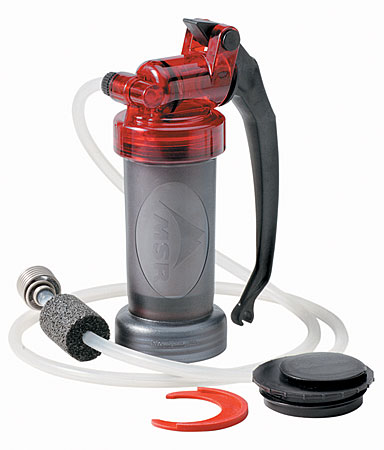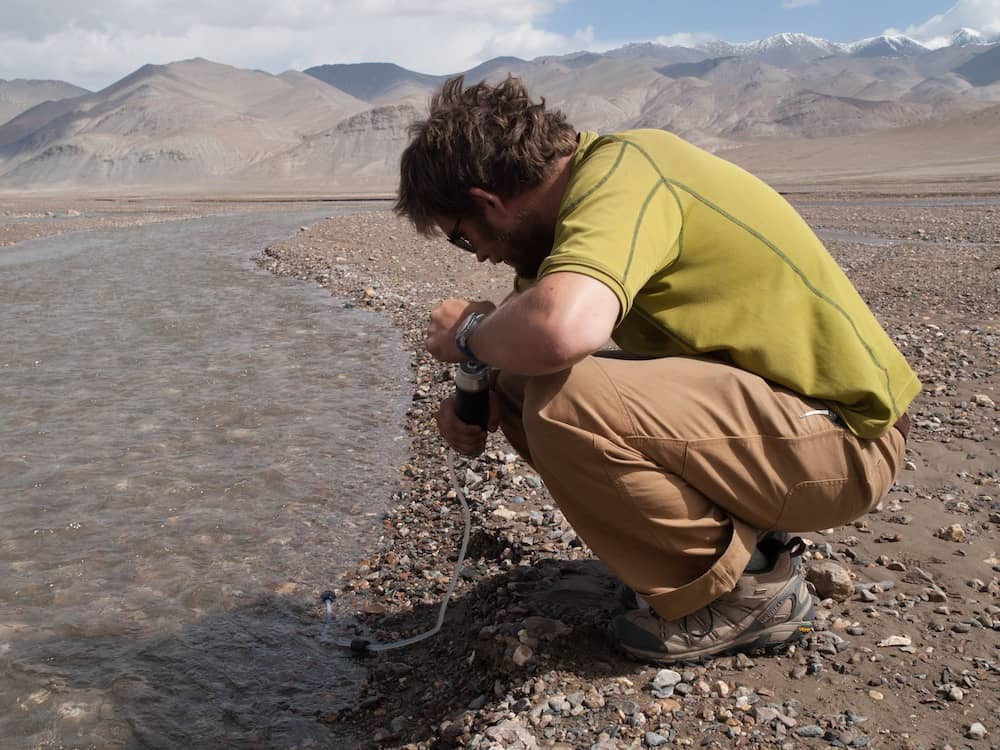Charlie Nordstrom using the Katadyn Pocket in the clear waters of the Wakhan Corridor
Every backcountry traveler understands the critical importance of clean drinking water. While dehydration is no picnic and can ultimately kill you, drinking water rife with nasty critters can just as easily bring the Reaper or make you so sick you’ll be calling his name. The most common waterborne pathogens in North America aren’t all too terrible, but they do harbor the potential for serious illness or worse. These nefarious micro-villains go by the names E. Coli, Giardia, and Cryptosporidium. There are other potential waterborne uglies to worry about, but those are three most likely to find their way into your fancy Snow Peak cup and down your hatch.
As we’ve all been taught, there are a number of ways to make unsafe water potable. You can boil it, treat it with chemicals, zap it with UV light, or mechanically extract the harmful pathogens with a filter. Which method is best is really a matter of deciding which method is best for your particular needs. As part of the new Expedition Portal Buyer’s Guide series, we’ll dive into the particulars of water treatment systems and sluice out a few of the options on the market today.
Considerations
Before you start shopping for your new filter or purification system, you need to first evaluate a few specific considerations:
- Water turbidity: Not all water treatment systems are ideal for treating water with a high level of sediments and suspended debris. A system best suited for the clear waters of the Rocky Mountains may not work well when confronted with desert water that looks more like chocolate milk than H2O.
- Volume of water to be processed: A solo traveler filling just a few small containers throughout the day may benefit from a different system than a large group needing to fill large water tanks once a week. In addition, some systems may only provide 100 liters of water in their lifespan, others, 50,000.
- Packed size: Does the system need to fit into a motorcycle pannier or can it get tossed in with the other luxuries in your Unimog? Packed size is important.
SteriPENAdventure Opti $89
The SteriPEN Adventure Opti is one of the most unique water purification systems on the market. Using the power of UV light, the SteriPEN doesn’t remove or kill the pathogens in your water, it renders them sterile; incapable of reproducing in your system in harmful numbers. In the field, the SteriPEN is incredibly easy to use. Collect a liter of water in any container, turn the unit on, follow the LED prompts, and stick the tempered glass bulb in the water. In just 90 seconds the light automatically turns off and your water is safe to consume. The whole event is unceremonious and even a bit anticlimactic, but it is highly effective and will neutralize anything including the rare and hard to combat waterborne virus.
Pros: The SteriPEN is small enough it can fit in your pocket. It can also treat very small quantities of water. If you don’t feel entirely confident in the glass of water your waiter just dropped at your table, zap it. Want to brush your teeth using the water at your third-world hotel? Poor it in a glass and nuke it. For the solo traveler it is extremely efficient, quick, and compact. One set of CR123 batteries can treat up to 100 liters and the bulb 8,000 liters.
Cons: The SteriPEN can only treat one liter at a time. For those needing to process large quantities of water, this is a deal breaker. It also does nothing to improve the turbidity or flavor of the water. This could be a mega bummer if your only water source is a murky cow tank.
Platypus Gravityworks 4.0L $119

The Platypus Gravityworks is exactly what you would expect it to be; it is a filtration system using good old gravity instead of elbow grease to filter water. Simply fill the “dirty” bag with untreated water and let gravity deliver it to the “clean” bag, ready to drink. Central to the Gravityworks is a unique filter element constructed of hollow fibers that remove everything larger than .2 microns. With a maximum lifespan of 1500 liters, the Gravityworks filter can process water at under a liter a minute making it a very speedy means of treating large volumes of water.
Pros: It doesn’t get much easier than filling a bag with water and waiting for a couple minutes. If your travels require large amounts of water to be processed in a single session, the Gravityworks is perfect. The entire system is extremely compact and light at only 305 grams.
Cons: Experience has taught us that processing water with a high level of sediment may clog the Gravityworks quicker than some other systems. Back-flushing the filter can usually remedy the situation, but it isn’t the best solution for people confronted with mucky water on a regular basis. Other than that, it’s hard to find many faults with the Gravityworks. As the name implies, it uses gravity and it really works.
Katadyn Pocket $299

If you have shopped for a filter lately, you may have noticed many have a toy-like quality about them. Plastic prevails in the filter market, but the Katadyn Pocket filter is built like a piece of commercial grade expedition equipment. The machined metal construction gives the Pocket a robust feel and the 20 year warranty inspires confidence that this is one filter you can rely on. The silver impregnated ceramic filter element can process an unparalleled 50,000 liters of water in its lifespan. It’s a beautiful example of engineering and manufacturing excellence. At a liter a minute, it’s also pretty quick. The price always draws a heavy sigh, but when you factor in the warranty, amazing longevity of the filter element, and quality of construction, it might be one of the best values in the industry.
Pros: The 50,000 liter capacity and 20 year warranty are unmatched by any other filter in this category. The speed and ease of use make this a great filter for large groups or situations that require large volumes of water to be processed in a single session. While water with high turbidity can clog this filter somewhat easily, it can be cleaned quickly and put back into use.
Cons: It is a heavy unit, which rules it out for those wanting a filter to use backpacking or bikepacking. It might even be too big to justify for some motorcycle travel. As is true for all ceramic element filters, a drop onto hard ground could render the filter useless, not that many people would fumble a $300 filter.
MSR MiniWorks EX $89

One of the most popular filters on the market, the MiniWorks EX is if anything, well proven. Known for their unfailing reliability, these filters have an ever growing fan base. The ceramic and carbon filter element is not just easy to clean, it vastly improves water flavor. If you have ever filtered from a pool of water choked with large amounts of decaying organic matter, that carbon component is very nice to have. For users in desert environments, the ability to quickly and easily clean a clogged filter is essential. The entire unit can be dismantled and serviced without the need for any tools. With a useful lifespan of 2,000 liters, the $40 filter cartridge isn’t cheap, but it is reliable.
Pros: The MiniWorks EX is undaunted by turbid water. It may clog quickly, but it can be returned to action in a matter of minutes. It’s very difficult to render the MiniWorks EX inoperable in the field. The price represents one of the best values in water treatment.
Cons: It’s not big, but it isn’t the most compact filter on the market. It may be too large for the solo traveler, especially the backpacker or bikepacker. MSR claims this filter will produce one liter per minute. That might be optimistic. It isn’t slow, but there are faster filters available. As is true for the Pocket, care must be taken not to drop the MiniWorks as that could break the ceramic element.
There are plenty of other fine filters on the market, but these four represent some of the best of their kind. What system is best for you is really a matter of matching your needs with the appropriate option. They all work as advertised and passed our field evaluations with flying colors.


